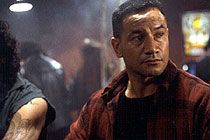|
|
|
|
What
Becomes of the Broken Hearted?
|
 |
|
At the end of Once Were Warriors (1994), Jake (Temuera Morrison) was left standing alone, abandoned by his wife, Beth (Rena Owen), and others close to him. Lee Tamahori's film painted a bleak portrait of an imploding, dead-end milieu, where desperate escape offered the only, slim hope for salvation. Now, in Ian Mune's loose sequel, What Becomes of the Broken Hearted?, Jake is also given a chance at self-improvement. The social conditions are still depressing, but at least Jake can find a few mates willing to take him, faults and all. And, like the anti-heroes of Robert Duvall's The Apostle (1997) or Ken Loach's My Name is Joe (1998), Jake's redemption lies in facing up to the 'original sin' of male violence tainting his soul. Alan Duff's adaptation of his 1997 novel concentrates equally on the plight of Jake's son, Sonny (Clint Eruera). Eaten up by a desire for revenge, and by unresolved hatred for his father, Sonny insinuates himself into a tough, youth gang, alongside Tania (Nancy Brunning). The film alternates, with no particular urgency, between Jake's tentative steps toward a new manhood, and Sonny's descent into a vicious circle of brutal payback. Eventually the two story lines become one, but by then it is too late to save the movie. What Becomes of the Broken Hearted? is a strangely unconvincing and listless melodrama. There is no such thing as subtext here: the characters spend all their time yelling about their problems with each other and the world. Meanwhile, the stagey action is hammily underlined by ominous, low camera angles and the menacing power-chords of David Hirschfelder's score. Once Were Warriors, too, was a pretty unsubtle melodrama – but at least it had intensity, focus and conviction. This sequel copies many of the incidental details of the first film – such as the emphasis on characters singing songs at every turn, in bars, loungerooms and even shops – but exhibits none of its drive or energy. In a sense, both films are examples of naïve cinema, akin to naïve painting – earnest movies with a manifest social conscience but no dramatic depth or filmic texture. The end result evokes a garish report in a tabloid newspaper: full of sensational snapshots of pain and confusion, and attention-grabbling headlines concerning the Big Issues, but finally low on both analysis and heart. © Adrian Martin July 1999 |
![]()